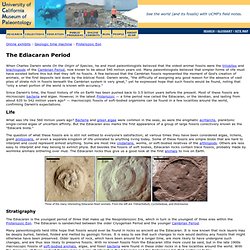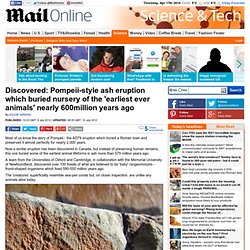

The Ediacaran Period. Online exhibits : Geologic time machine : Proterozoic Eon The Ediacaran Period When Charles Darwin wrote On the Origin of Species, he and most paleontologists believed that the oldest animal fossils were the trilobites and brachiopods of the Cambrian Period, now known to be about 540 million years old.

Many paleontologists believed that simpler forms of life must have existed before this but that they left no fossils. A few believed that the Cambrian fossils represented the moment of God's creation of animals, or the first deposits laid down by the biblical flood. Darwin wrote, "the difficulty of assigning any good reason for the absence of vast piles of strata rich in fossils beneath the Cambrian system is very great," yet he expressed hope that such fossils would be found, noting that "only a small portion of the world is known with accuracy. " Since Darwin's time, the fossil history of life on Earth has been pushed back to 3.5 billion years before the present. Life Stratigraphy Localities. A new fossil species found in Spain. In the '80s, Spanish researchers found the first fossils of Cloudina in Spain, a small fossil of tubular appearance and one of the first animals that developed an external skeleton between 550 and 543 million years ago.

Now palaeontologists from the University of Extremadura have discovered a new species, Cloudina carinata, the fossil of which has preserved its tridimensional shape. "Cloudina carinata is characterised by its elaborate ornamentation and complexity of the shells and tube that are formed when inserted", Iván Cortijo, main author and researcher in the Area of Palaeontology at the University of Extremadura, describes to SINC.
Fossils show earliest animal trails. (PhysOrg.com) -- Trails found in rocks dating back 565 million years are thought to be the earliest evidence of animal locomotion ever found, Oxford University scientists report.

Trails found in rocks dating back 565 million years are thought to be the earliest evidence of animal locomotion ever found. The newly-discovered fossils, from rocks in Newfoundland in Canada, were analysed by an international team led by Oxford University scientists. They identified over 70 fossilised trails indicating that some ancient creatures moved, in a similar way to modern sea anemones, across the seafloors of the Ediacaran Period.
The team publish a report of their research in the February edition of the journal Geology. ‘The markings we’ve found clearly indicate that these organisms could exert some sort of muscular control during locomotion,’ said Alex Liu of Oxford University’s Department of Earth Sciences, an author of the paper. Explore further: Changing dinosaur tracks spurs novel approach. Namibian fossils reveal ancient oddities. Pompeii-style ash eruption which buried nursery of the 'earliest ever animals' nearly 600m years ago. By Eddie Wrenn Published: 10:23 GMT, 9 July 2012 | Updated: 06:55 GMT, 10 July 2012 Most of us know the story of Pompeii - the AD79 eruption which buried a Roman town and preserved it almost perfectly for nearly 2,000 years.

Now a similar eruption has been discovered in Canada, but instead of preserving human remains, this one buried some of the earliest animal lifeforms in ash more than 579 million years ago. A team from the Universities of Oxford and Cambridge, in collaboration with the Memorial University of Newfoundland, discovered over 100 fossils of what are believed to be 'baby' rangeomorphs - frond-shaped organisms which lived 580-550 million years ago.
The 'creatures' superficially resemble sea-pen corals but, on closer inspection, are unlike any animals alive today. A juvenile 'Trepassia wardae' showing the fine detail of its branching pattern: This specimen is just 3 millimetres wide Found here: The rocky shore at Mistaken Point Ecological Reserve, Newfoundland. Ronacollina acula: Oldest animal with a skeleton discovered. Coronacollina acula may also help us recognise life elsewhere in the universe By Ted Thornhill Published: 09:55 GMT, 9 March 2012 | Updated: 12:23 GMT, 9 March 2012 At between 550 and 560 million years old, an animal discovered in South Australia recently is the oldest with a skeleton ever found.

The organism, called Coronacollina acula, was found by a team from the University of California. The finding provides insight into the evolution of life – particularly, early life – on the planet, why animals go extinct, and how organisms respond to environmental changes. Rock on: These are the best Coronacollina specimens showing the main body with articulated spicules The discovery also can help scientists recognise life elsewhere in the universe. Coronacollina acula lived on the seafloor.
The researchers believe it ingested food in the same manner a sponge does, and that it was incapable of moving around. ‘It therefore provides a link between the two time intervals,’ Droser said.